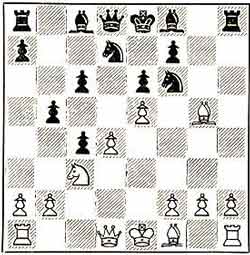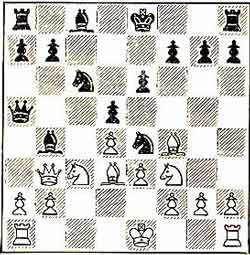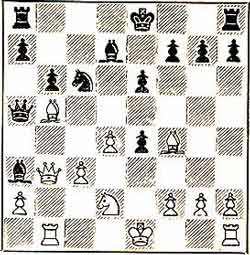The games of the U.S.A.-
U.S.S.R Radio Match are re-
published with annotations b y the American players.
The second part of this series will appear next month.
1.
MY GAMES WITH BOTVINNIK
by Arnold
S. Denker CHESS REVIEW
NOVEMBER 1945 |
|
17 Kt-Kt3? . . . .
The
fatal mistake. 17 P-KKt3 would still have held the game together,
although White would have had to weather a very strong King-side
attack.
17
. . . . PxP
18
BxP
. . . .
White cannot allow Black’s pawns to continue their menacing march.
But now Botvinnik has the opportunity to carry out a powerful
attack.
18
. . . . Q-B3!
Naturally not 18….QxB?; 19 R-B1 winning the queen.
19 P-B3 P-Q6!
Threatening to win a piece with 20…QB4-ch. The opening of the
diagonal QB4-KKt8 is disastrous for white.
20 Q-B1
. . . .
I
was under no illusions about what was coming. If 20 B-K3, B-B4 wins.
20
. . . . B-B4ch!
21 K-R1
Or 21 B-K3, P-Q7!; 22 QxP, Kt-K4 winning a piece.
21
. . . .
Q-Q3!

22
Q-B4
. . . .
If 22 B-B4 (or 22 B-KR6, P-Q7! and wins), RxPch!; 23 KxR,
R-R1ch; 24 Kt-R5, RxKtch; 25 K-Kt3, P-K4!!; 26 B-K3, QxP; 27 K-B2, R-R7
with an irresistible attack.
No better is 22 P-B4, RxPch!;
23 KxR,R-R1ch; 24 Kt-R5, RxKtch; 25 K-Kt3, RxBch, etc.
But the text is likewise
inadequate. The stage is set for black.
22
. . . . RxPch!
I had been suffering for
several moves in anticipation of this stroke. It was almost a relief
to see it played!

23 KxR R-R1ch
24
Q-R4
Rx Qch
25
BxR
Q- B5
The icing on the cake. Black
wins one of the bishops. At this point I radioed my resignation with
the following message: “ Congratulations. Beautifully played.” |
|
|

Mikhail Botvinnik
Arnold S. Denker
|
United States Champion Arnold S. Denker as doubly unfortunate
in his games with Mikhail Botvinnik. The Soviet grandmaster not only
put his encyclopaedic knowledge of the openings to good use: he was
in suberb form, winning both games by a series of smashing
irresistible blows. Many a qualified judge felt that no opponent
could hold Botvinnik at the height of his powers.
-Ed.
QUEEN’S GAMBIT DECLINED
A. S. Denker M. Botvinnik
White
Black
1 P-Q4 P-Q4
2
P-QB4
P-K3
3
Kt-QB3
P-QB
4
Kt-B3
Kt-B3
5
B-Kt5
. . . .
This move , obvious as it may seem, posed a problem for me. I knew
that after 5 B-Kt5, Botvinnik would have an opportunity to play a
pet variation with which he is thoroughly familiar, having devoted a
considerable amount of study to it. 5 P-K3 was a simple and
excellent alternative for White; but I felt that evading 5 B-kt5
would not be in keeping with the spirit of the occasion. Hence I
accepted Botvinnik’s challenge.
5.
. .
.
PxP
6
P-K4
. . . .
6
P-K3, PKt4 gives Black excellent prospects of retaining the gambit
pawn. The text, on the other hand, attacks the QBP and at the same
time threatens P-K5.
6
. . .
.
P-Kt4
He
disregards the coming P-K5-all part of his plan.
7 P-
K5 P-KR3
8
B-R4 P-Kt4
9
KtxKKtp
. . . .
Seemingly very powerful.
However, Botvinnik is fully prepared for it.
9. . . . PxKt
10 BxKtp QKt-Q2

11 PxKt
. . . . |
|
|
The first step to perdition. There is no hurry about
this move, since the Knight is pinned and lost in any event.
In the 1944 Soviet Championship, both Lillenthal and Mikenas played
11 P-KKt3! Against Bovinnik, obtaining an excellent game. The point
is that the fianchetto of White’s KB gives him a very long diagonal,
in view of the earlier weakening of black’s position by ….P-QKt4.
I had looked at both of these games rather superficially and got the
impression that Botvinnik’s play was far from best. Hence I felt
that he must have found some improvements and so decided to take the
game into channels where we would both be on our own.
11
. . .
.
B-QKt2
Now
it is too late for white to fianchetto his KB.
12 B-K2
A
developing move, to be sue, but he Bishop is much more modestly
posted here than at Kt2.
12 . . . . Q-Kt3
Preparing for queen-side castling, keeping the QP under observation
and also lending additional strength to the eventual thrust of the
QBP. White’s extra pawn is purely academic.
13 O-O O-O-O
14
P-QR4
. . . .
If 14 B-B3, Kt-K4 leaving White the cruel
choice between losing his QP or parting with the valuable KB.
14 . . . . P-Kt5
15 Kt-K4 P-B4

|
By now I realized that my unfortunate eleventh move
had made things very easy for Bovinnik .Black has freed his game and has
a well-nigh perfect position – with the KR file still to be heard from!
16 Q-Kt1 . . . .
I had counted on this move to turn the tide,
but I always remained one tempo short
of gaining the initiative.
16 . . . . Q-B2
The immediate 16….QB3 is not quite
so good, for example 17 P-B3, PxP;
18 BxP, Q-B2; 19 P-KKt3 and White
can defend himself for some time to come.
 |
|
QUEEN’S GAMBIT DECLINED
M.Botvinnik A.S. Denker
White Black
1 P-Q4 P-Q4
2
Kt-KB3 Kt-KB3
For quite a while I favored the
Tarrasch Defense because of its lively, open character. However, it
subsequently underwent so much detailed analysis that my interest in it
faded.
Hence in this game I decided on
the Slav defense. A solid and substantial line of play: I wanted to forget
any preconceived analytical notions and intended to play a game of chess.
3 P-B4 P-B3
4 PxP
. . . .
To avoid the kind of imbalanced
pawn position which would arise after Black is permitted to play…PxP. As
in his game with Smyslov in the last USSR Championship
(CHESS REVIEW, June/July, P.11), Botvinnik exchanges immediately, with a
view to a symmetrical position in which
White has a minimal
advantage by reason of having the first move.
In such a stabilized
position, there is less likelihood that either side can win. In view of my
attitude at the beginning of this game – do or die for the good old USA-
this was quite a damper on my enthusiasm.
Botvinnik’s choice of this line of
play is a tribute to his understanding of such psychological fine points.
4 . . . . PxP
5 Kt-B3 Kt-B3
This is a kind of Four Knights’
Game transferred to the Queen-side!
6 B-B4 Q-R4
Black’s choice is a hard one: if he plays 6 …. P-K3, he
is likely to suffer from his QB’s lack of mobility; but if he plays 6…
B-B4, the bishop is often exposed to attack! The text is an attempt to
postpone a decision
The pin on the QKt really has no theoretical basis, as
White can defend himself against the pin without any trouble. But I was
determined to give the game an interesting turn. It often happens that the
element of surprise is enough to justify even an untheoretical move.
7 P-K3 Kt-K5
8 Q-Kt3 P-K3
9 B-Q3 B-Kt5 |
Continuing to reinforce the
pin: an idea in motion
( remember Newton’s law?) tends to remain in motion.

10 QR-B1 KtxKt
The alternative was 10…. P-B4, to
reinforce the advance Knight at K5. But this would create a bad hole at
Black’s K4 and leave him with a weak KP.
11 PxKt B-R6
Black wants to gain time by
tempoing on the rook, but the move can easily lead to serious trouble.
12 QR-Kt1 P-QKt3?
Typical of my impetuous mood.
Black’s position is still solid. First 12…O-O, followed possibly by 13…
P-QKt3 and subsequent occupation of the QB file, was indicated.
13 P-K4! PxP??
But here 13….O-O was indicated.
Then the onus of capitalizing on the freer development rests on White.
After the text, Botvinnik wins in sparkling style.
 |
14 B-QKt5! B-Q2
15
Kt-Q2!
. . . .
Threatening 16 Kt-B4. What can
Black do about it?

15 . . . . P-QR3
Not 15… O-O-O; 16 Kt-B4, KtxP; 17
KtxQ, KtxQ; 18 B-R6 mate.
Or else 15 ….B-K2; 16 Kt-B4, KtxP; 17 BxBch, KxB; 18 R-Q1 etc.
16 BxKt BxB
17 Kt-B4
. . . .
Simultaneously attacking Black’s
queen and KB, and therefore forcing Black’s reply.
17…. Q-KB4
18 B-Q6!
. . . .
Settles the argument. The rest is
only a matter of time.
18 . . . . P-K6
19 KtxKp QxRch
20 QxQ BxB
21 QxKtP K-Q2
22 Q-Kt3 QR-QKt1
23 Q-B2 R-Kt4
24 O-O R-KR4
25 P-KR3 R-QKt1
26 P-QB4 P-Kt3
27 Kt-Kt4 R-KB4
28 Kt-K5ch BxKt
29 PxB RxKP
30 Q-Q2ch Resigns
For 31 R-Q1 will be
decisive.
|







